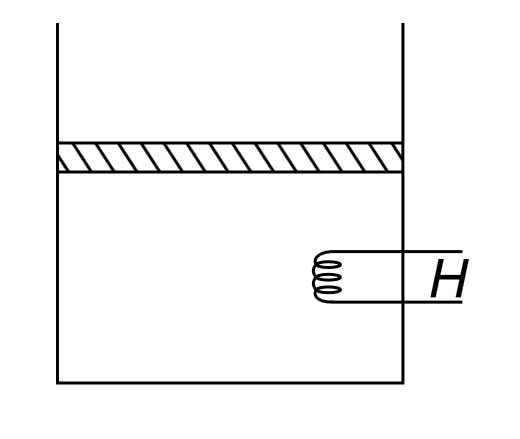An LPG cylinder weighs 14.8kg when empty. When full it weighs 29.0kg and the weight of the full cylinder reduces to 23.2kg. Find out the volume of the gas in cubic metres used up at the normal usage conditions and the final pressure inside the cylinder. Assume LPG to be n-butane with normal boiling point of 0∘C.
Weight of full cylinder =29kg
Weight after usage =23.2kg
Gas consumed =29−23.2=5.8kg or 5800g
For butane (C4H10), M=58
Normal pressure =1atm
Room temperature =298K
PV=nRT
or 1×V=580058×0.0821×298
or V=2446.58L≈2.447m3
Topper's Solved these Questions
- STATES OF MATTERBook:CENGAGE CHEMISTRYChapter:STATES OF MATTERExercise:Ex 5.1
Explore 15 Videos
- STATES OF MATTERBook:CENGAGE CHEMISTRYChapter:STATES OF MATTERExercise:Ex 5.2
Explore 16 Videos
- STATES OF MATTERBook:CENGAGE CHEMISTRYChapter:STATES OF MATTERExercise:Archives (Integer)
Explore 1 Video
- SOME BASIC CONCEPTS AND MOLE CONCEPTBook:CENGAGE CHEMISTRYChapter:SOME BASIC CONCEPTS AND MOLE CONCEPTExercise:Archives Subjective
Explore 11 Videos
- STOICHIOMETRYBook:CENGAGE CHEMISTRYChapter:STOICHIOMETRYExercise:Archives Subjective
Explore 33 Videos
Similar Questions
An LPG (liquefied petroleum gas) cylinder weighs 14.8 kg when empty. When full it weighs 29.0 kg and shows a pressure of 2.5 atm. In the course of use at 27∘C, the weight of the full cylinder reduces to 23.2 kg. Find out the volume of the gas in cubic metres used up at the normal usage conditions, and the final pressure inside the cylinder. Assume LPG to be n-butane with normal boiling point of 0∘C.
View SolutionAn LPG cylinder weighs 14.8kg when empty. When full it weighs 29.0kg and the weight of the full cylinder reduces to 23.2kg. Find out the volume of the gas in cubic metres used up at the normal usage conditions and the final pressure inside the cylinder. Assume LPG to be n-butane with normal boiling point of 0∘C.
View Solution
Knowledge Check
A compressed cylinder of gas contains 1.50×103 g of N2 gas at a pressure of 2.0×107 Pa and a temperature of 17.1∘C. What volume of gas has been released into the atmosphere if the final pressure in the cylinder is 1.80×105 Pa ? Assume ideal behaviour and that the gas temperature is unchanged.
A1264 LB126 LC12600 LD45 L
An L.P.G. cylinder weight 14.8 kg when empty. When full, it weighs 29 kg and shows a pressure of 2.5 atm. In the course of use at 27∘C, the weight of the full cylinder reduced to 23.2 kg. Find out the volume of n−butane in cubic metres used up at 27∘C and 1 atm. [Mol. mass of butane = 58]
View SolutionAn L.P.G. cylinder weight 14.8 kg when empty. When full, it weighs 29 kg and shows a pressure of 2.5 atm. In the course of use at 27∘C, the weight of the full cylinder reduced to 23.2 kg. Find out the volume of n−butane in cubic metres used up at 27∘C and 1 atm. [Mol. mass of butane = 58]
View SolutionAn L.P.G. cylinder weight 14.8 kg when empty. When full, it weighs 29 kg and shows a pressure of 2.5 atm. In the course of use at 27∘C, the weight of the full cylinder reduced to 23.2 kg. Find out the volume of n−butane in cubic metres used up at 27∘C and 1 atm. [Mol. mass of butane = 58]
View SolutionAn empty LPG cylinder weighs 14.8 kg. When full, it weighs 29.0 kg and shows a pressure of 3.47 atm. In the course of use at ambient temperature, the mass of the cylinder is reduced to 23.0 kg. The final pressure inside the cylinder is atm. (Nearest integer) (Assume LPG to be an ideal gas)
View SolutionAn empty LPG cylinder weighs 14.8 kg. When full, it weighs 29.0 kg and shows a pressure of 3.47 atm. In the course of use at ambient temperature, the mass of the cylinder is reduced to 23.0 kg. The final pressure inside the cylinder is atm. (Nearest integer) (Assume LPG to be an ideal gas)
View SolutionThe thickness of a hollow metallic cylinder is 2 cm. It is 70 cm long with outer radius of 14 cm. Find the volume of the metal used in making the cylinder, assuming that it is open at both the ends. Also find its weight if the metal weighs 8 g per cm3.
View SolutionAir is contained in a vertical piston – cylinder assembly fitted with an electric heater. The piston has a mass of 50 kg and cross sectional area of 0.1m2. Mass of the air inside the cylinder is 0.3 kg. The heater is switched on and the volume of the air slowly increases by 0.045m3. It was found that the internal energy of the air increased by 32.2kJ/kg and that of the piston increased by 0.06 kJ/kg. Assume that the container walls and outer surface of the piston are well insulated and there is no friction. The atmospheric pressure is 100 kPa. Determine the heat transferred by the heater to the system consisting of air and the piston.

View Solution
